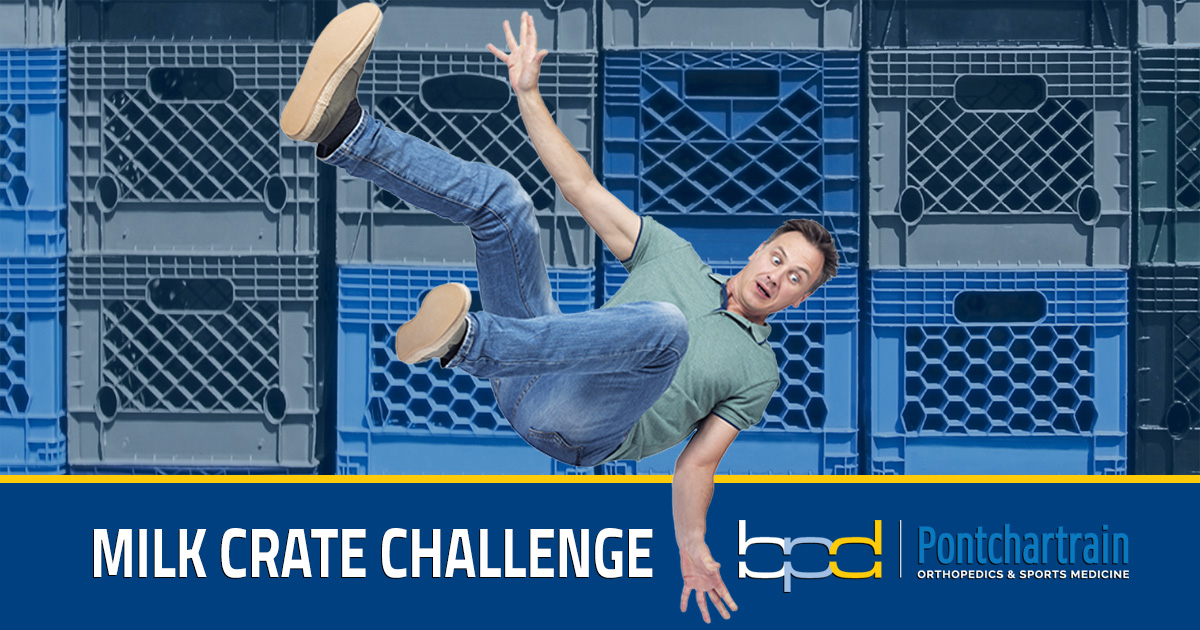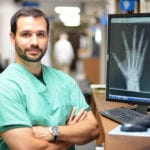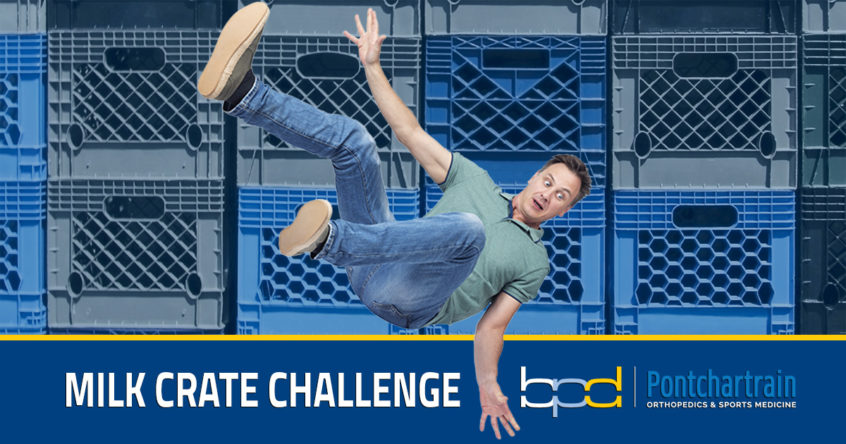
If you have a social media account, chances are you've seen people trying-- and failing-- to complete the milk crate challenge. And while falling down can be funny, as an orthopedist, I see the real world injuries that can happen as a result of such a fall. In today's post "Milk Crate Challenge Injuries", I'll explain what can happen when you fail the milk crate challenge (and why no one should even try).
So, what is the milk crate challenge?
The milk crate challenge is a viral trend that is currently taking social media by storm. The challenge involves stacking milk crates into the shape of a pyramid, usually seven crates high at the tallest. Then, the person attempting the challenge must climb up one side of the pyramid and down the other, all without falling or knocking over the milk crates. Though some of the viral videos of this challenge feature people succeeding with the challenge, many of the most popular uploads are of disastrous failures.

A group of mostly teenagers constructed a monstrous stack of black milk crates
at Copeland Park in North Tampa, FL. [Photo credit Justin Garcia | CL Tampa]
Why is the milk crate challenge dangerous?
The average milk crate measures 12 inches tall. This means that a person standing on a tower of seven crates runs the risk of taking a seven-foot fall. Given the height and awkward angles of the falls, as well as the impact with the milk crates during the fall, potential physical harms could include a wide range of orthopedic injuries. Because our reflex is to try to catch ourselves when we fall, the potential for serious hand, wrist, and elbow injuries are very high. In addition, the risk of falling on a milk crate could further complicate any possible injuries.
Milk crate challenge injuries
Injuries from falls onto an outstretched hand occur so frequently that orthopedic physicians describe them with the acronym “FOOSH”. The conditions that occur from FOOSH injuries can include:
Wrist Fractures
A broken wrist usually occurs when there is an impact to the wrist bones. One of the most common causes is landing on an extended hand in an attempt to break or catch a fall. >>Click here to learn more about wrist fractures<<
Wrist Ligament Injuries
A wrist ligament injury can typically occur when a person falls on or twists their wrist. Wrist sprains frequently appear in athletes who play sports like baseball, basketball, gymnastics, and skating. >>Click here to learn more about wrist ligament injuries<<
Distal Radius Fractures
The two bones of the forearm are the ulna and radius. The radius is the larger of the two and is most commonly broken. When it is broken on its distal end (near the wrist), the fracture is called a distal radius fracture. The most common cause of distal radius fractures is falling on an outstretched arm. >>Click here to learn more about distal radius fractures<<
Forearm Fractures
The forearm is primarily responsible for rotating itself, the wrist, and hand—turning the palm upwards and downwards. It also helps bend and straighten the elbow. The two bones of the forearm are the radius and ulna. Either can be fractured by a direct blow or a fall onto an outstretched arm. >>Click here to learn more about forearm fractures<<
Scaphoid Fractures
The scaphoid is typically fractured due to a fall on an outstretched hand, such as slipping on a sidewalk or falling on roller skates or a Hoverboard. This causes the wrist to hyperextend, placing force on the scaphoid and causing a fracture. >>Click here to learn more about scaphoid fractures<<
Hook of Hamate Fractures
The hamate bone is one of eight small carpal bones located in the wrist. The hamate bone is the wedge-shaped bone located on the outside of the wrist on the same side as your pinky finger. One side of the bone has a hook shape. A fracture of the hook of hamate may be caused by a fall onto the wrist. >>Click here to learn more about hook of hamate fractures<<
Triangular Fibrocartilage Tears
The triangular fibrocartilage complex (TFFC) is located on the pinky side of the wrist. The TFCC performs the important functions of stabilizing, cushioning, and moving the wrist joint. TFCC tears can be caused by falling onto an outstretched hand. >>Click here to learn more about triangular fibrocartilage tears<<
Elbow Fractures
The elbow is extremely vulnerable to injury from force or repetitive use. Elbow fractures can range in severity but always need medical attention for proper healing to occur. Elbow fractures can result from direct blows to the elbow and falling onto an outstretched arm with the elbow locked in extension. >>Click here to learn more about elbow fractures<<
"There is never a good reason to attempt to climb an unstable structure like a pyramid of milk crates. The best way to avoid serious orthopedic injuries is simple - steer clear of dangerous situations."Brandon P. Donnelly, MD
How to avoid milk crate challenge injuries
There is never a good reason to attempt to climb an unstable structure like a pyramid of milk crates. The best way to avoid serious orthopedic injuries is simple - steer clear of dangerous situations. If you are considering attempting this challenge, I ask, as an orthopedist, that you reconsider. Your health and strength are not worth risking for social media “likes” and “follows”.
Don’t risk it, especially during a pandemic
As I discussed in my blog post on personal safety during the pandemic, now is not the time to be taking unnecessary risks. I’d like to encourage parents to talk to your kids about the true danger of what could happen if they attempt this challenge.
If you or a loved one has sustained an injury from falling on an outstretched hand (caused by the milk crate challenge or not), please contact my office for a consultation with a hand specialist.
About Dr. Brandon P. Donnelly, MD
 Dr. Brandon P. Donnelly is a board certified hand surgeon with Pontchartrain Orthopedics & Sports Medicine. Dr. Donnelly completed his hand and microsurgery fellowship at the prestigious Philadelphia Hand to Shoulder Center. Dr. Donnelly treats all ages of patients in the greater New Orleans area for hand, wrist, and elbow conditions.
Dr. Brandon P. Donnelly is a board certified hand surgeon with Pontchartrain Orthopedics & Sports Medicine. Dr. Donnelly completed his hand and microsurgery fellowship at the prestigious Philadelphia Hand to Shoulder Center. Dr. Donnelly treats all ages of patients in the greater New Orleans area for hand, wrist, and elbow conditions.
This site is not intended to and does not provide medical advice, professional diagnosis, opinion, treatment or services to you or to any other individual. Through this website and links to other websites, Brandon P. Donnelly, MD provides general information for educational purposes only. The content provided in this website and links, is not a substitute for medical care or treatment. You should not use this information in place of a consultation or the advice of your healthcare provider. Brandon P. Donnelly, MD is not liable or responsible for any advice, course of treatment, diagnosis or any other information, services or product you obtain through this site.

